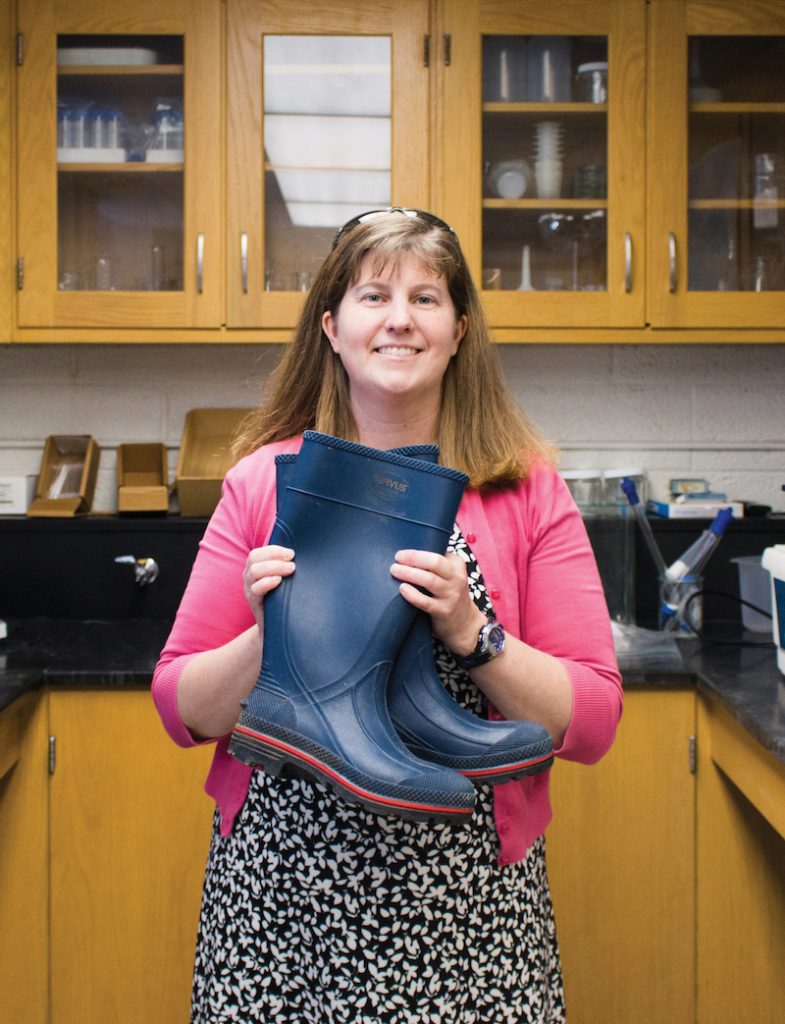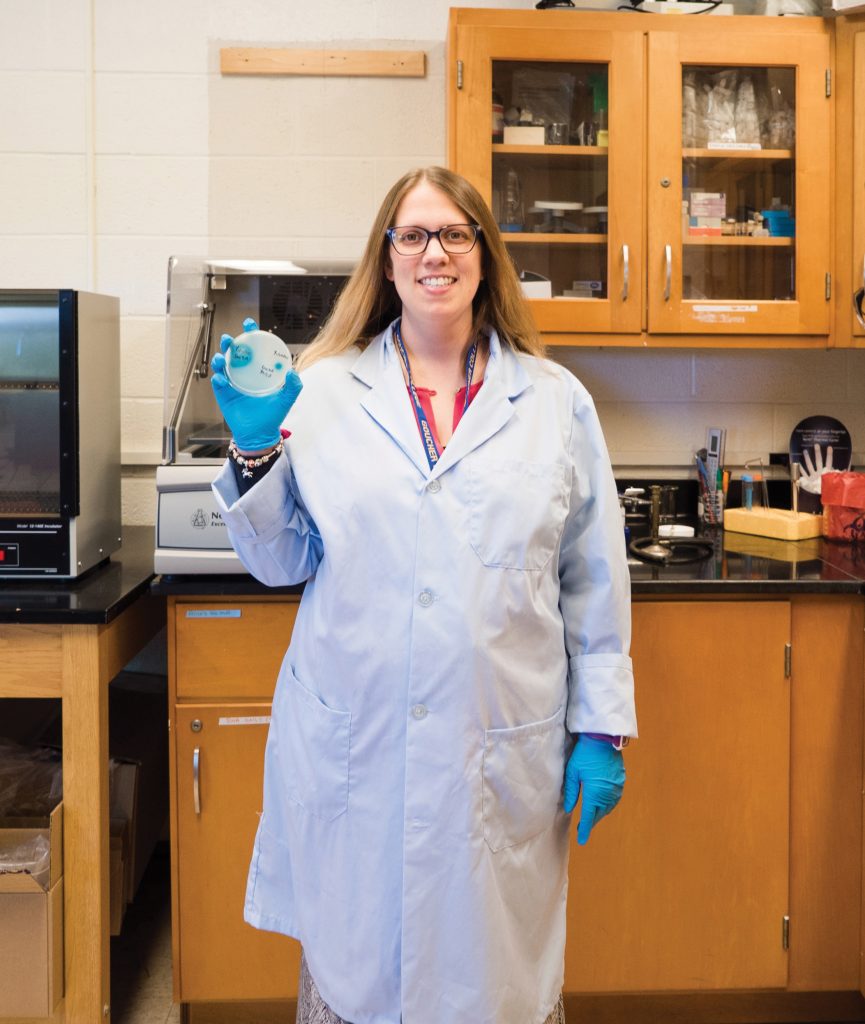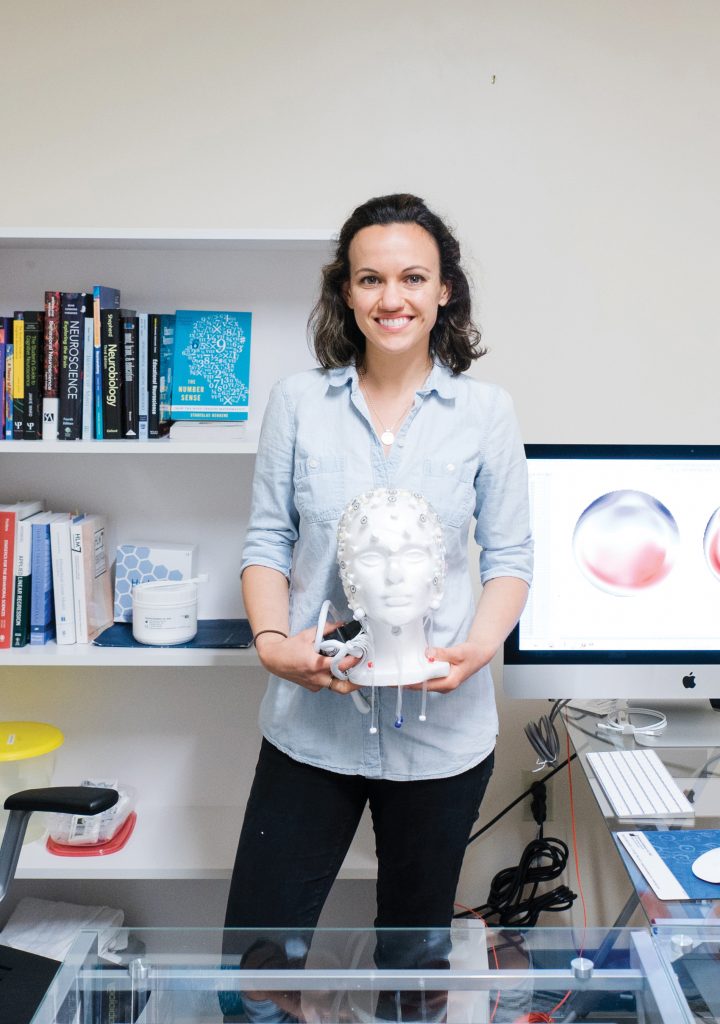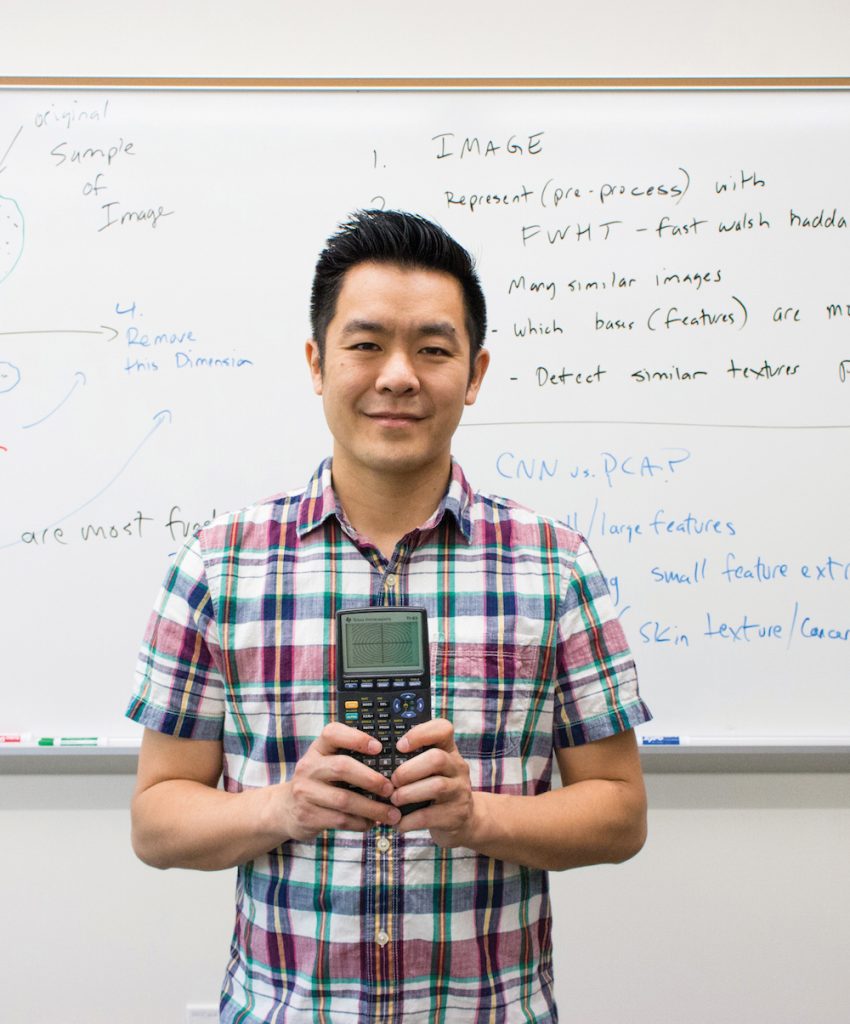Goucher’s Summer Research Program gives science faculty a chance to work on their own pet projects, and students a chance to join them in their research. Chemistry Professor Kevin Schultz, who has been organizing the summer program for the past three years, says it gives students a chance to work on real, potentially ground-breaking projects with their professors.
“It’s my favorite part of the job,” he says. “You get to work one on one with students, you get to work on something you’re passionate about, and share that joy of discovery.”
Even if students don’t continue on to grad school, he says, the analytic thought process they practice doing real research stays with them. And it isn’t all work. Schultz works with light-activated molecules in a dark lab, so he says he tries to get outside with his students at least once a day. They also plan activities as a group—last year they volunteered at Our Daily Bread, which provides food to homeless Baltimoreans, and went tubing down the Shenandoah River. Many of the students will present their work at the summer’s Landmark Research Symposium, along with students from other schools in the Landmark Conference.
Biology and Chemistry Professor Judy Levine says summer research was already an annual undertaking when she started at the college in 1992, but about four years into her tenure here, she worked to make it more stable, negotiating with then-president Bob Welch to get funding for the researchers through the college. Much of it is still funded that way, though outside awards and grants make up a portion.
“We wanted to make sure there would always be opportunities for students to do summer research,” she says. “There’s a ton of evidence that doing actual research—as opposed to the canned research in lab classes—is very important for students. It motivates them, gets them inspired about science.”
This year, 10 faculty and 24 students will be taking part. Both will be paid stipends over the summer, supported by endowed funds and external grants. We sat down with the science faculty at the end of a busy semester to find out what they would be studying this summer, and what it all means.
The Eyes Have It
Assistant Professor of Biology Jenny Lenkowski

Zebrafish, small minnows with distinctive horizontal stripes, are native to the Himalayas, but they’ve found their way into aquariums and laboratories around the world. Researchers, like Goucher Assistant Professor of Biology Jenny Lenkowski, prize them for their regenerative abilities. Lenkowski’s work focuses on their ability to regenerate the neuron cells in their eyes after an injury, an ability that would be invaluable to other animals, including humans. Last fall, Lenkowski won a three-year grant from the National Institutes of Health Eye Institute that will go toward hiring Elizabeth Hannifin ’17 as a research technician and upgrading equipment. Three current students supported by the grant and Goucher Summer Research will work with her this summer to study how cells communicate when they are dividing during development and regeneration of the retina in the eye.
Molecule Makers
Associate Professor of Chemistry George Greco

Creating new molecules is big business, for the pharmaceutical and other industries, but making them, which can require expensive catalysts like platinum and palladium, isn’t cheap or easy. Chemistry professor George Greco locates a poster on the wall in Hoffberger to explain what he and his student have been working on. Most of the molecules have the distinctive hexagonal shape of organic chemistry notations, that is, they contain six carbon atoms. Less common, he says, are eight-carbon molecules, and that is what they’re trying to create, using inexpensive nickel as a catalyst. Greco says their work could result in new and useful ways to make interesting molecules.
Healing Crystals
Associate Professor of Physics Rodney Yoder

For the past few years, Physics professor Rodney Yoder has been working with pyroelectric crystals—crystals that produce strong electrical fields when heated—and he thinks they may have a new practical application. It may be possible, using multiple crystals, to create and accelerate a beam of electrons, creating a miniature particle accelerator. There are lots of applications for such particle beams (the Large Hadron Collider in Switzerland, for example, creates and crashes together two ultra-high-energy particle beams in order to study the reactions produced), but Yoder is aiming for a more everyday, small-scale use. If his predictions are accurate and he can get the arrangement of crystals right—and he and his students will start working on that this summer—he says it should be possible to create a tiny x-ray source. That’s at least a few years away, he says, but could lead to interesting applications in medicine and beyond.
In the Tall Grass
Associate Professor of Biology Cynthia Kicklighter

Studying predator-prey relationships may conjure visions of watching big cats taking down ungulates, but Associate Professor of Biology Cynthia Kicklighter observes observes predation of a quieter variety. It takes place along the shores of the Chesapeake Bay, and could provide insight into an invasive marsh grass threatening to choke large parts of the Bay’s ecosystem. Phragmites, the grass in question, may have come to these shores in the holds of European ships, but once it established itself here, it became a successful and relentless propagator. Its predator? The humble marsh snail, which damages the leaves of the plant, then feeds off the fungus that grows on it. But something about Phragmites drives the snails away, and toward other, native, grasses, giving the invader an even bigger advantage. Kicklighter, who last year received a Research Opportunity Award from the National Science Foundation for her work, studies chemical defenses, and has been working to isolate the chemical responsible for deterring the snails. This summer she’ll be working with students to collect and analyze plants taken from the Eastern Shore side of the bay.
Making Things With Light
Assistant Professor of Chemistry Kevin Schultz

Chemistry Professor Kevin Schultz’s research involves using light to trigger a change in molecules. Specifically, he and his students will be working on using light to cause a molecule to release a drug, nitroxyl, which has anti-cancer properties. To do that, they’ll need to design and synthesize a photo-reactive molecule that reacts in just the right way to give up its drug payload. Schultz says this method could be used for very precise delivery of treatment to areas of a patient’s body without an injection. Other projects in Schultz’s lab include developing new luminescent probe molecules, which can relay information about their surroundings inside the body by emitting different colored light, and molecules that can be used in photo-dynamic therapy—the use of infrared light-activated molecules to destroy nearby cancer cells.
Fixing Fish Farms
Assistant Professor of Biology Anna Jozwick

Enteric Redmouth is a particularly nasty disease that infects farm-raised fish, causing burst blood vessels and, eventually, killing them. First discovered in Idaho in the 1950s, it’s now found all over the world, and though there’s a vaccine, it’s not 100 percent effective, and if Redmouth does strike, farmers have to kill their entire stock. Biology Professor Anna Jozwick has been studying the bacteria Yersinia ruckeri, which causes Redmouth, first for the U.S. Department of Agriculture, and since last year, in her lab at Goucher. She’s currently looking at a phenomenon called quorum sensing—a system of communication between bacterial cells related to population density. Redmouth only breaks out in crowded fish farms, never in nature, where the fish (and the bacteria) are less densely packed. If she and her students are able to isolate—and potentially disrupt—the communication signals that start the outbreak, it could save a lot of fish, and save fish farmers a lot of money.
All In The Mind
Assistant Professor of Psychology Gillian Starkey

Psychology Professor Gillian Starkey’s research is focused on examining examining the neural basis of how we learn. Starkey came to Goucher from Stanford last year, where she did her post-doctoral work, to set up a to set up a cognitive neuroscience research laboratory in Goucher’s Center for Psychology. She uses electroencephalography to look at the electrical impulses inside her subjects’ brains, via a device that looks like a hairnet with flat discs resting against their scalps. This summer, she and two students will be studying the brain activity of children (ages 8 to 10) as they do simple math problems, counting the number of objects on a screen in front of them. The results will be compared to adult brains doing the same tests, as part of an effort to study the development of simple math skills.
Small Differences
Assistant Professor of Mathematics Phong Le ’03

If you’ve used Facebook lately, you may have noticed that it’s pretty good at detecting faces in your pictures. The process at work is large feature detection—an algorithm looks for the big things that make up a face, and decides what qualifies. Mathematics Professor Phong Le ’03 is working on small feature detection—the algorithm he’s working with looks at the details of an image to distinguish textures, the way things are patterned. It’s easy for human eyes to distinguish, for example, between wood grain and clouds in a blue sky or grains of sand on a beach, but those seemingly simple distinctions can trip up a computer. Le’s students will be testing an algorithm against different textures in an attempt to figure out where those points of confusion are, and how to make it more successful. His interest is in the math, but if they can come up with a fast and elegant way to detect those differences in texture, he says down the road it could have applications in, for example, determining the quality of textiles, or even detecting skin cancers.
Fruit Fly Expressions
Associate Professor of Biology Mark Hiller

Biology professor Mark Hiller and his students will be looking at fruit flies this summer. Very, very closely. Hiller has two projects, both involving research-standby drosophila. One group will be looking at mechanisms of gene expression in the tiny insect. How, that is, does the same DNA, present in every cell, get the message during development that a portion of that DNA should be turned on, or expressed, at the right time and in the right place to become, say, a neuron, or muscle tissue. Another group of students will be looking at a specific set of genes in the fruit fly, which, because of their structure, they are believed to act as sugar transporters. Experiment-based information on these genes is slim, making them a good candidate for further research. Because humans and drosophila share about 60 percent of their DNA, the flies are often used to study human diseases, so any research that expand the knowledge about these much-studied creatures can have a practical use down the road.
